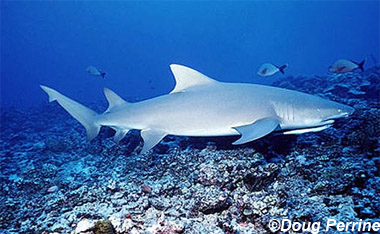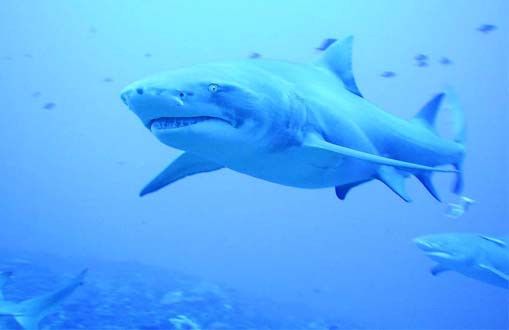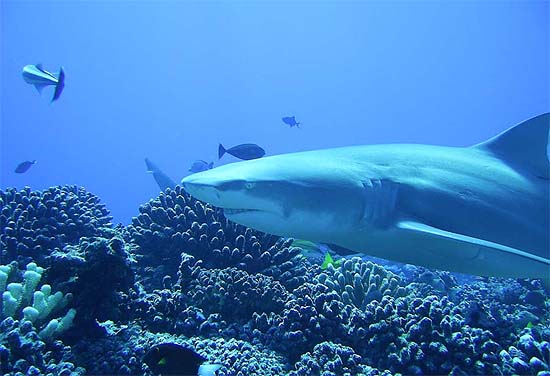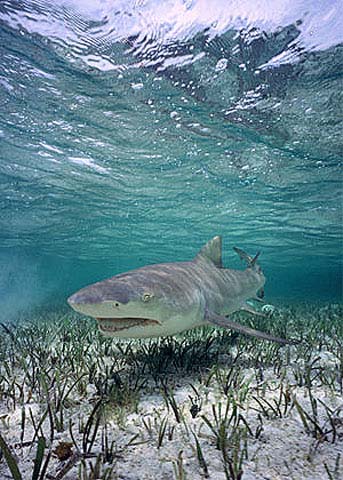Sicklefin Lemon Shark

Negaprion acutidens
This shy, sedate shark isn’t much of a threat to humans unless provoked. It can get quite large though, upward of 14 feet long, and it closely resembles its sister species the Lemon Shark, except for the slightly more exaggerated curve of its pectoral fins. Typically yellowish brown with a pale underside, it has a wide, wedge-shaped snout and the streamline body of a requiem shark.
Order: Carcharhiniformes
Family: Carcharhinidae
Genus: Negaprion
Species: acutidens
Common Names
English language common names are sicklefin lemon shark, broadfin shark, Indian lemon shark, Indo-Pacific lemon shark, lemon shark, sharptooth lemon shark,and sharptooth shark. Other common names include arava (Tahitian), cá nhám ngh? (Vietnamese), cação-pardo (Portuguese), dandan (Portuguese), echarivus (Tobian), farluuq (Somali), geelhaai (Afrikaans), gursh (Arabic), iho (Cebuano), libax (Somali), limão foiçador (Portuguese), malie (Samoan), papa (Swahili), pating (Tagalog), pilal (Tamil), remonzame (Japanese), requin citron (French), requin citron faucille (French), requin grandes ailes (French), requin limon faucille (French), seglfinnet citronhaj (Danish), sikkelvincitroenhaai (Dutch), te unun (Kiribati/Tuvaluan), tiburón aletón (Spanish), tiburón segador (Spanish), tidak ada (Bahasa Indonesia), and zitronenhai (German).
Importance to Humans
The sicklefin lemon shark is caught off the coasts of several countries for its meat, liver oil, and fins for shark fin soup. The meat is utilized fresh and dried salted for human consumption. It is hardy in captivity and often displayed in public aquarium facilities.

Danger to Humans
This species is quite shy when approached by divers, being reluctant to approach even when bait is presented. Even so, caution is advised when encountering this shark. The sicklefin lemon shark will respond quickly and aggressively when poked, speared or otherwise provoked and will attack humans or boats when accosted. Due to its large size, bulky body and massive head possessing large dagger-like teeth, this shark should be treated with respect as a potentially dangerous species.
Conservation
This shark is believed to be vulnerable to overfishing due to its restricted distribution and habitat preference. There is some evidence of local extinctions off the coasts of Indian and Thailand which adds credibility to this fear. It is also susceptible to habitat degradation as coral reefs are being destroyed by cyanide and dynamite fishing while mangroves are threatened by development interests. Currently there are no conservation measures in place for this species.
> Check the status of the sicklefin lemon shark at the IUCN website.
The IUCN is a global union of states, governmental agencies, and non-governmental organizations in a partnership that assesses the conservation status of species.
Geographical Distribution

The sicklefin lemon shark is found in the Indo-Pacific region in the Red Sea and from South Africa (including Mauritius, Seychelles, Madagascar) to the Philippines, north to Vietnam, and south to Australia. It has also been reported from Palau, the Marshall Islands, and Tahiti as well as Taiwan.
Habitat
Residing on continental and insular shelves and terraces, the sicklefin lemon shark is common on coral reefs as well as in shallow, sandy-bottom lagoons, and mangrove swamps. The range of depths at which this shark is found ranges from 0-302 feet (0-92 m). It is a sluggish shark that tends to swim slowly along the bottom, with frequent rest periods on the substrate. However it is occasionally observed near the surface, especially when tempted by potential prey. Young sharks are often observed on reef flats, where water is shallow enough to expose their dorsal fins.
Biology

Distinctive Features
This shark has a large, stocky body with a broad, blunt snout. The two large dorsal fins are of equal size. The first dorsal fin originates over or behind the pectoral fin free rear tips with its midbase closer to the pelvic bases than the pectorals and its free rear tip slightly anterior, over, or slightly posterior to the origins of the pelvic fins. The second dorsal fin is nearly as large as the first with its height being 4/5 or more of the first dorsal height. Its origin is about opposite or slightly anterior to the origin of the anal fin. The pectoral fins are broad and triangular with lengths from the origin to free rear tip over 2/3 of the pectoral fin anterior margins. The pectoral fin originates under the interspace between the third and fourth gills slits. The anal fin is somewhat smaller than the second dorsal fin. The dorsal, pectoral, and pelvic fins are strongly falcate. There is no interdorsal ridge and no lateral keels on the caudal peduncle.
The sicklefin lemon shark is almost identical to the lemon shark (Negaprion brevirostris), however it can be distinguished by the rear edge of the pectoral fins, which are slightly more curved, or sickle-shaped.
Coloration
The body is yellowish-brown in color, hence its common name of lemon shark. It is paler along the ventral surface.
Dentition
The teeth are strongly differentiated in the upper and lower jaws. The serrations are weakly developed on the blades of the upper teeth in individuals measuring 4.6 feet (1.4 m) long and larger, while absent in small individuals 2.3 feet (0.7 m) or less. The lower jaw teeth lack cusplets and are mostly erect, fairly long with slightly hooked cusps and no serrations. The cusps of the lower teeth do not protrude when the mouth is closed. There are 27-33 rows of teeth in each jaw.
Denticles
Sicklefin lemon shark dermal denticles are large and overlapping with 3 to 5 ridges.
Size, Age, and Growth
The maximum size of the sicklefin lemon shark is 149.6 inches (380 cm) total length (male). Maturity is reached at total lengths ranging from 86.6-94.5 cm (220-240 cm) for both males and females of this species. Growth rates for juveniles are 4.9-6.1 inches/year (12.5 -15.5 cm/year).
Food Habits
The sicklefin lemon shark feeds on smaller sharks, stingrays, and benthic bony fishes.

Reproduction
As a viviparous species, the sicklefin lemon shark gives birth to 1-14 pups per litter following a gestation period of 10-11 months. The young are born in October or November or December or January, depending on locality. The pups measure approximately 17.7-31.5 inches (45-80 cm) total length at birth.
Predators
Potential predators of the sicklefin lemon shark include larger fish including sharks.
Parasites
Two new species, Paraorygmatobothrium roberti n. sp. and Paraorygmatobothrium arnoldi n. sp. (Tetraphyllidea: Phyllobothriidae), have been observed in the spiral intestines of both the sicklefin lemon shark and the lemon shark (N. brevirostris). In addition, the cestode Paragrillotia spratti (Cestoda, Trypanorhyncha) has also been documented from the spiral valve of the sicklefin lemon shark. Platybothrium jondoeorum n. sp. (Tetraphyllidea: Onchobothriidae) has also been reported in this shark.
Taxonomy
The sicklefin lemon shark was originally described by Rüppell in 1837 as Negaprion acutidens. Synonyms include Carcharias munzingeri Kossmann & Raeuber, 1877; Carcharias forskaelii Hemprich & Ehrenberg, 1899; Eulamia odontaspis Fowler, 1908; Aprionodon acutidens queenslandicus Whitley, 1939; Mystidens innominatus Whitley, 1944; Hemigaleops forsteri Schultz & Welander; and Odontaspis madagascariensis Fourmanoir, 1961. Negaprion is a genus of requiem sharks within the family Carcharhinidae. This genus includes this species in addition to one other living species, Negaprion brevirostris (lemon shark).
Prepared by: Cathleen Bester